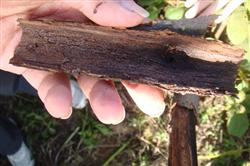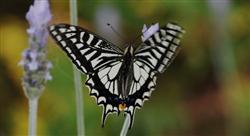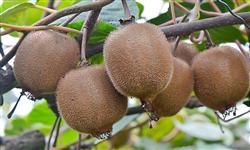How to prevent and cure kiwifruit canker?

What harm does kiwifruit canker have? How to prevent and cure kiwifruit canker? Have not understood the netizens to help introduce kiwifruit canker is a bacterial disease, with concealed, explosive and destructive characteristics, the appearance of symptoms can not be judged whether there is the disease, symptoms once the loss caused by irreparable, light branches withered, tree trunks produce disease spots, serious death of the whole plant, causing a serious threat to the healthy development of kiwifruit industry. The planting network has sorted out the symptoms and control methods of kiwifruit canker, which are listed in detail below for netizens' reference. Symptoms of kiwifruit canker: canker mainly harms leaves, fruits and branches, and seriously affects fruit yield and fruit quality. Most of the disease starts from stem buds, lenticels, deciduous scars and branch bifurcations, showing water stains at first, then disease spots expand, color deepens, cortex and xylem are separated, and hand pressure is soft. In the later stage of kiwifruit canker, the cortex of the diseased part longitudinally cracked and cleared white mucus. The mucus soon turned reddish brown. The disease spot can expand rapidly around the stem, cut open the diseased stem with a knife, the cortex and medulla turn brown, and the medulla is full of milky white bacterial pus. The upper branches and leaves of the damaged stems wilted and died. If the disease occurs at the base, new branches can germinate near the ground or the rootstock, and new branches can germinate near the ground or the rootstock. The diseased part first forms a red dot with an inconspicuous yellow halo on the periphery, and then the small spot expands to 2-3 mm irregular dark green spot, the leaf color is dark green, the yellow halo is obvious, and the width is about 2-5 mm. Under wet conditions, the spot can be rapidly expanded into a large water-like spot, which is polygonal due to the limitation of leaf veins. The cause of kiwifruit canker: kiwifruit canker is mainly transmitted through seedlings, scions and other planting materials and fruits. Kiwifruit seedlings are more likely to be infected with this disease than adult trees, and the older the trees are, the lighter the disease is. Canker is beneficial to the disease under the condition of low temperature and high humidity. The average temperature in spring is 10-14 ℃. In case of heavy wind and rain or continuous high-humidity overcast and rainy weather, the disease is easy to spread. The growing period of new shoots is the peak period of disease, and most of it is cloudy and rainy in May, which provides favorable conditions for the occurrence and prevalence of canker, so we must actively prevent and cure canker in this prone period. Control methods of kiwifruit canker: method one, enhance the potential of kiwifruit trees and improve soil fertility. Increase the application of organic fertilizer, improve the soil, achieve loose and fertile soil, in order to facilitate the expansion and deep binding of kiwifruit roots, vigorously promote formula fertilization, kiwifruit should hang fruit in real time, reasonable load, scientific management, maintain strong tree potential, and improve the ability of resistance to canker. Method 2. Select disease-resistant kiwifruit varieties, select, cultivate and plant disease-resistant varieties, gradually eliminate susceptible varieties, and fundamentally improve the resistance of excellent varieties to canker. Method 3. Disinfect the selected seedlings by adding 1% alcohol to agricultural streptomycin solution containing 700 units per milliliter for 1.5 hours. Method 4. Scientific pruning of kiwifruit trees: generally pruned in December in winter, the pruning knives are disinfected with 90% alcohol, and one plant is disinfected once, the mouth of the scissors should be smooth and smooth, and the large wound should be reduced. After the end of winter shearing, spray "seal three mouths" (fruit stalk mouth, petiole mouth, cut mouth), and take the dead branches and leaves out of the garden to burn. Combined with pruning to remove disease and insect branches, diseased leaves, long branches, drooping branches, etc., all the branches through which bacteria and pus flow should be cut off to reduce the source of infectious diseases. The period from the end of February to the first and middle of March is the period of plant bleeding, which is not suitable for pruning. Search regularly during the peak period of ulcer disease in spring, and once more seriously affected plants are found, they will be cleared and burned in time to control the spread of bacteria. Method 5. After fruit harvest or before winter, combined with orchard pruning, the Beginning of Spring was generally sprayed with 1 ∶ 1 ∶ 100 Bordeaux solution or 50% copper succinate (DT) wettable powder 500 times after sprouting and before sprouting, and spray 50% plus Ruinong wettable powder 500 times at an interval of 10 days. Method 6. Scrape the rod and spray in time when a disease is found: first scrape off the diseased bark and sawdust (transport the diseased bark and sawdust out of the garden and burn it), when close to good skin, scrape part of the good skin after scraper disinfection, and then apply the rod with 500 times of 95% bacterial Lingyuan powder or 60% chlorothalonil 30 times or 50 times of 5% bacteriological detergent, 4 times 5 times, once every 7 days. At the same time, combined with 95% bacterial Lingyuan powder 2000 times plus penetrating agent or 5% bacteriological clear water agent 300 times plus penetrating agent and other agents were sprayed 4 times 5 times, once every 7 days. Method 7. Vertical smear and spray control: use a sterilized knife to make a vertical stroke on the vine disease spot, the cut should be larger than the disease spot, and then smear it with medicine, smear 4 times 5 times, once every 7 days, combined with spray 4 times 5 times, once every 7 days, the medicament can be used for 95%CT carbendazim powder 2000 times or 5% bacteriological clear water agent 300 times penetrating agent. Click to get more kiwifruit planting techniques click to get more fruit planting techniques
- Prev

What is citrus butterfly?
What is citrus butterfly? How does the citrus butterfly grow and what is the harm? Is there any way to control citrus butterflies? Also ask experienced netizens to help introduce the growth habits and harm of citrus butterflies as well as prevention and control methods, which are listed below for netizens' reference. The growth habits of citrus butterflies.
- Next

How to bag kiwifruit?
How to bag kiwifruit? What is there to pay attention to? Also ask the netizens who know to help introduce that kiwifruit bagging can reduce sunburn, leaf grinding, prevent diseases and insect pests and fruit surface pollution, improve the appearance quality of fruit, and ensure the safe production of kiwifruit. The planting network sorted out the bagging operation method of kiwifruit.
Related
- Moge, come on! The staff of the peasant association in the producing area of cantaloupe were frightened when the crowd gathered.
- Causes and Solutions of low Fruit setting rate of Apple
- Symptoms and control measures of passion fruit virus disease
- Fruit growing lesson: how do apple orchards keep high yields?
- Can you build orchards in the mountains? What are the pros and cons?
- How to manage the coloring period of Crisson grape?
- This paper introduces the processing technology of two kinds of fig products.
- How much is a month for retired teachers in rural areas by 2020?
- How can strawberry planting increase sugar content? We should pay attention to management in many aspects.
- What are the cultivation techniques on how to improve the yield of golden fruit?

